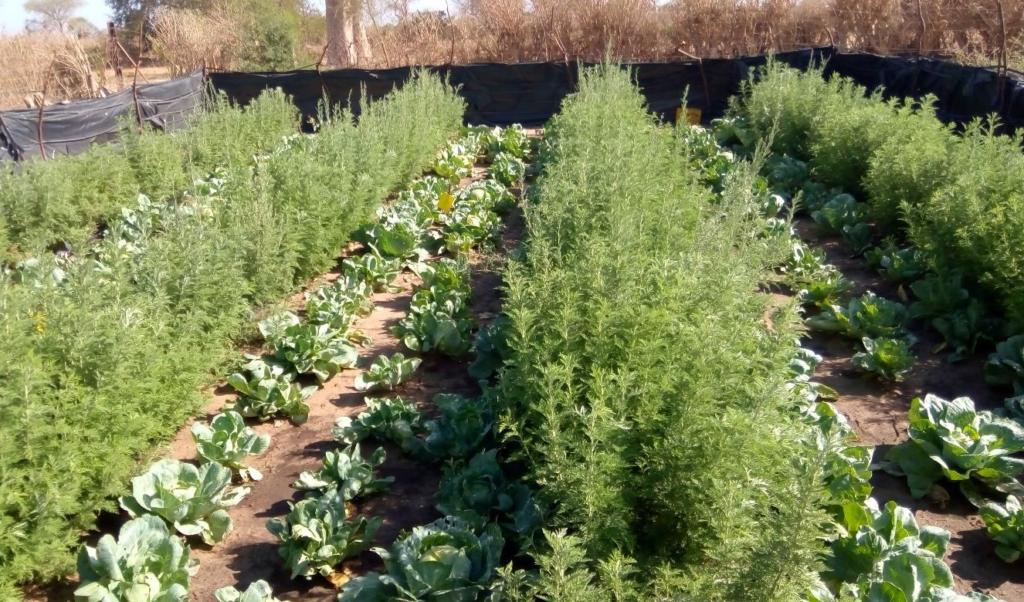Cultivation Artemisia afra
Download in pdfThe principles of good agricultural management must be respected. Where appropriate, conservation agriculture (agro-ecology) should be used, particularly with regard to the accumulation of organic matter (compost, mulching) and conservation of soil moisture (mulching, sustainable irrigation). [1]
Farmers should adopt practices that contribute to soil conservation and reduce erosion, such as creating buffer zones along watercourses and planting cover crops and green manure (to be incorporated into the soil when ploughing) [1].
These agroecological techniques are described in the AGRISUD Guide [2].
Choice of where to plant

As Artemisia afra is a perennial bush, think carefully about where to plant as its location will be permanent! Once it has been in the ground for several months, it does not tolerate well being transplanted elsewhere.
Allow for at least 1 m between Artemisia afra plants because they grow at least 1 m wide.
For example, Artemisia afra plants can be planted in rows with plants 1 m apart so that they touch each other, with a 2 m gap before the next row to allow for layering and passage for harvesting.
Adapting these measurements by alternating the Artemisia with trees, market gardening and subsistence crops is strongly recommended.
It is also quite possible to grow individual plants in pots or in the open ground.
Preparation of the plot

Prepare the plot for transplanting at the same time as the seedbed. These operations are labor intensive and can be time consuming. They should be done about 2 months before planting.
if possible, he growing area to avoid damage from wandering animals.
Cattle should not be allowed to enter the growing area [1].
plough only if necessary. Avoid slash-and-burn agriculture which destroys soil life!
.
to remove stones and weeds.
if the soil is poor (see AGRISUD Guide [2] p 97 to 103 - Organic manure).
to loosen the soil and form cultivation beds or ridges as appropriate.
(drainage channels) to drain the soil if the crop is grown in the rainy season.
WHO recommends that soil should contain appropriate amounts of nutrients, organic matter and other elements [1].
Ideally, a soil test should be performed and the results recorded in the batch and cultivation record.
Add manure to the soil, preferably 2 weeks prior to transplanting.
This does not dispense you from adding compost and manure as part of regular plant care.
Transplanting

approximately one hand deep (approx 20 cm, depending on the roots).
generously to loosen the soil and facilitate transplanting and recovery of young plants (in an intensive cultivation system with irrigation, irrigate the plot for 4 hours, about 15mm).
to remove any lumps and mix in a large handful of compost (approx 200 g).
Use of mineral fertiliser (including urea and NPK) is not allowed in organic farming! As nitrogen (N) is a determining factor for growth it is possible to add ground horns (from slaughterhouses) to the compost.
the seedbed or propagation site to loosen the soil before removing the plants.
the seedling, keeping a clod of earth around the roots!
around the plant to retain water close to the roots.

Mulching
Mulching the rows with fresh or dry organic matter (green plant waste) helps limit the need for water and weeding,
reduces soil erosion and provides additional nutrients.
Use any type of straw, tops, grasses, cereal crop residues, cut or crushed corn plants, decomposed palm oil leaves… Avoid woody material that attracts termites. Favour local reclaimed products!
(See Guide AGRISUD [2] p 143 to 144 – Mulching).
For example, citronella can be pruned every 15 or 21 days to produce the necessary mulch.
In Togo, RCW (Ramial Chipped Wood) gave good results with rice straw, palm branches, young green branches of Moringa and Neem.
A system of cultivation on plant cover or using cover plants can also be considered (see Guide AGRISUD [2] p 197 to 207).

Plant care
Artemisia afra is very fragile in the early stages of growth. The first few months are crucial for it to become strong and lignified.
morning and evening every day using a watering can, hose, sprinkler or drip for the first 3 months. Irrigate early in the morning and late in the evening or at night to reduce evaporation and consequent water loss.
3 months after transplanting the Artemisia afra, if it is properly established, watering can be limited to 2 or 3 times a week
regularly after transplanting and then every month as required.
after each weeding
For best results, add 1 handful of compost 1 month after transplanting, 2 handfuls 2 months after transplanting, 3 handfuls 3 months after transplanting and 4 handfuls 4 months after transplanting.
IMPORTANT: Do not cover the leaves to avoid the risk of burning! Spread the compost in a circle around each plant
Do not flood the soil, but moisten it well. Reduce watering according to rainfall during the rainy season.
It is essential to adapt the type of manure taking into account the specific growing conditions of the region: soil type, climate, possible irrigation.
Nutrient inputs differ according to the type of compost. Compost made with poultry droppings provides about 3 times more nitrogen than compost made with donkey manure, cattle manure, pig manure or green waste. Triple doses of non-poultry manure compost!
Animal manure must be carefully decomposed to meet health standards for acceptable limits of microbial contamination and to destroy the germination capacity of weeds. Human excrement should not be used as fertiliser because of the possible presence of infectious microorganisms and parasites. Any application of manure should be documented. [1]
and act quickly in case of disease (such as the appearance of mould if watering is too heavy) or pests (goats, rabbits, cattle, termites, grasshoppers, ...)!
if necessary, from the sun or wind when young plants are first planted out.
about variations in the shape and height of the plants.











